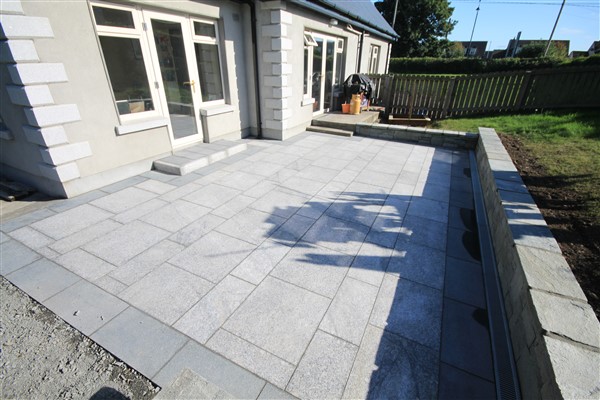Granite is a material that is well-known for its strength and timeless beauty. It also has a special property that is sometimes overlooked: it can cool. Using granite in your landscape design can offer a beautiful and natural way to cool yourself when the summer heat gets too much.
Let’s look at the science behind granite’s cooling properties, check out various innovative ways to use it in landscape design, and discover how granite’s low maintenance needs help with sustainability efforts.
Interpreting the Cooling Properties of Granite
Granite remains cool even in direct sunlight because of its composition and physical qualities. Granite has a high thermal conductivity because it is composed of volcanic material formed when molten lava slowly solidifies deep under the Earth’s crust. It is the ideal material to fend off the scorching summer heat because of its feature, which enables it to disperse and absorb heat effectively. Granite’s light color and solid construction not only reflect sunlight but also lessen heat absorption.
It has a sturdy, non-slip surface with flecks of gold, yellow, and white. In your landscape attempts, use them to create a startling contrast against darker backdrops or to accent a bold color scheme.


Granite Integration in Landscape Architecture
The options are virtually limitless when it comes to using granite in your landscape design. Granite can make your outdoor space more aesthetically pleasing and cozy by helping you create everything from large patios to elaborate paths and ornamental accents. Consider adding granite slabs or pavers to your high-traffic areas, such as walkways and seating sections, to create a cool surface for enjoyment and leisure. Not to mention the thoughtful positioning of granite boulders, which provide visual appeal and serve as organic heat sinks to assist in controlling temperature swings.
Sustainability and Maintenance
Granite is a very desirable material for landscaping due to its long-lasting sturdiness and low care requirements. Granite is a sustainable material for outdoor applications since it withstands the weather with little care, in contrast to many synthetic materials that need to be replaced and maintained often. It usually requires routine cleaning with a mild soap and water solution to keep its appearance and performance intact for many years. Moreover, granite’s durability lessens the need for replacements that need a lot of resources, which helps with environmental conservation.
Using granite’s cooling properties in summer gardening creates a pleasing balance of sustainability, use, and aesthetic appeal. Granite is a flexible and long-lasting material that can be utilized to create welcoming outdoor spaces that stay comfortably cool even in the warmest summers, whether it is used in hardscape elements or as natural accents. You may fully utilize granite in your landscaping projects supplies by granite suppliers by being aware of its cooling properties, adopting creative design techniques, and placing a high value on sustainability and upkeep.
Granite’s Quarrying and Fabrication
Systematic granite quarrying dates back to 4000 B.C., a time before the usage of hardened metals. Quarrying methods changed extremely slowly over the ages until the 20th century, when industrial methods made it possible to mine enormous amounts of stone at a reasonable price. Granite resources near the earth’s surface are mined for huge blocks using drive-in quarrying techniques and low-compression explosives. After being transported by truck or rail from the quarry to a fabrication plant, the granite blocks are sawed into slabs with the appropriate thickness. After that, each slab is put through mechanized machinery to apply the necessary finish.
Because granite is so hard, a lot of the production process involves using diamond-edge saw blades or a diamond slurry, which raises the cost of the final product considerably. But because to recent developments in the mining and production processes, granites are now available at rates comparable to, or sometimes even lower than, solid surface materials and man-made granite substitutes.


Aesthetical Properties
A greater understanding of the various types of stone that are available and how to utilize them is necessary due to the growing demand for stone use in a wide range of architectural applications. The most popular ones include sandstone, limestone, granite, marble, and travertine. Every stone has distinct physical qualities that influence how well it fits into a particular design. While all stones have a place in contemporary architecture, interior applications most frequently use granite and marble. They both offer numerous lovely possibilities and enable a highly polished surface. But they are not at all the same.
Granite is the densest and hardest building stone available. Its dense grain almost repels stains, making it ideal for any interior application. Its high-gloss finish, if polished, will hold up under challenging conditions. Granite is a dependable stone for various uses because of these qualities, which are perfect for floors and countertops.
The Conclusion
Granite is not just a beautiful but also a sturdier natural stone that makes it a wonderful choice for both residential and commercial construction. However, there is another feature that makes granite a great choice and that is its cooling properties. This property makes it a stone of choice for areas that usually remain hot. If you are looking for cool and beautiful granite stone for an ongoing or upcoming project, make sure you choose from the leading granite suppliers to get the top quality stone material.
